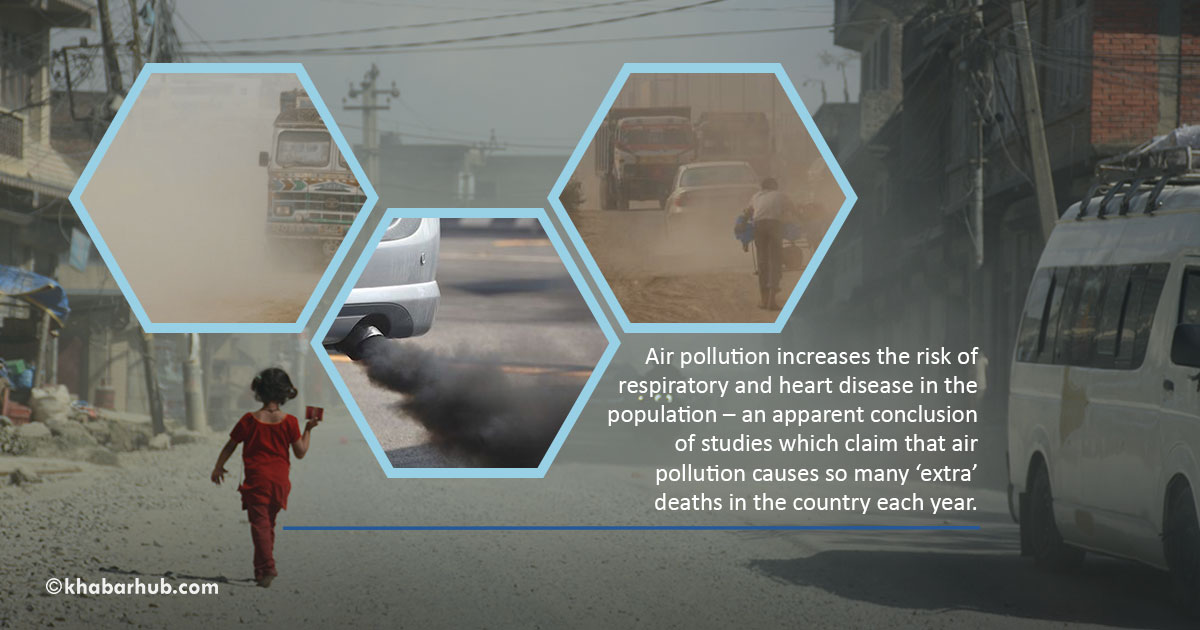KATHMANDU: Surprising but true. In Nepal, air pollution kills a staggering 35,000 people annually due to various deadly diseases linked to it.
In fact, air pollution increases the risk of respiratory and heart disease in the population – an apparent conclusion of studies that claims that air pollution causes so many ‘extra’ deaths in the country each year.
Air pollution has been the world’s largest environmental health risk. It was linked to the death of an estimated seven million people worldwide every year, according to the data from the World Health Organization (WHO).
A study that looked at the exposure to air pollution was recently published in the medical journal JAMA. The study found that long term exposure to air pollution, especially ground-level ozone, black carbon, nitrogen oxides, and fine particulate matter, is like smoking about a pack of cigarettes a day for many years.
Dr Tedros Adhanom Ghebreyesus, the WHO’s director-general said this back in October 2018, “The world has turned the corner on tobacco. Now it must do the same for the ‘new tobacco’ – the toxic air that billions breathe every day, No one, rich or poor, can escape air pollution. It is a silent public health emergency.”
Both short and long term exposure to air pollutants has been associated with health impacts. More severe impacts affect people who are already ill. Children, the elderly and poor people are more susceptible.
A study that looked at the exposure to air pollution was recently published in the medical journal JAMA. The study found that long term exposure to air pollution, especially ground-level ozone, black carbon, nitrogen oxides, and fine particulate matter, is like smoking about a pack of cigarettes a day for many years.
That, sadly, is the air we breathe, the air that the children breathe and it is only getting worse.
The tete-a-tete on air pollution is not new in Nepal but has become part of our daily lives, almost every day.
When it comes to doing something about air pollution, people often tend to focus on ideas and thoughts that are beyond control and end up ignoring aspects that we could control.
Going over the basics, Particulate Matters (PM) — tiny solid and liquid particles in the air — hang in the atmosphere for a while before they are deposited on the ground.
In Nepal, the biggest culprits behind air pollution are vehicular emissions followed by dust. These two together account for over half of the pollution we face and more than 60 percent PM2.5 particles.
On the last day of 2019, Kathmandu Valley’s PM10 concentration level averaged at 200 μg/m³ and the PM2.5 average was 137 μg/m³, according to the data provided by the Ministry of Forests and Environment.
To put that in perspective, the WHO guidelines for safe levels of PM are at 25 μg/m³ for PM2.5 particles and 50 μg/m³ for PM10 particles.
For simplicity, we can split all the PM into 2 groups. The first group, PM10, is for particulate matters that are between 2.5 μm (micrometers) to 10 μm. The second group, PM2.5, is for particles that are smaller than 2.5 μm in diameter.
These particles are so small that they can make their way directly into the human lungs and that is what makes them more dangerous. Air quality measurements typically describe such PM concentrations in terms of micrograms per cubic meter (μg/m³).
In Nepal, the biggest culprits behind air pollution are vehicular emissions followed by dust. These two together account for over half of the pollution we face and more than 60 percent PM2.5 particles.
Vehicular emissions are the source of significant amounts of nitrogen oxides, carbon monoxide, and other pollutants. The number of vehicles in Nepal had reached 3.22 million by the year 2018.
Of the total number of vehicles registered in the country so far, 2.5 million are just motorbikes and it just so happens that motorbikes generally generate more pollutants and smog than cars.
Although motorbikes are more fuel-efficient and emit less carbon dioxide, they emit far more smog-forming hydrocarbons and oxides of nitrogen, as well as the toxic air pollutant carbon monoxide, which is poisonous.
In 1999, Nepal introduced the “green sticker” in an effort to monitor exhaust emission in Kathmandu Valley. These days’, we hear, that drivers can buy the green sticker and even have it delivered just for an extra thousand rupees – hope that is not true.
There is no point to a green sticker on a car spewing out black smoke all over. The authorities need to check if a car with a Green Sticker still has a smoky tailpipe and strictly enforce the law.
Vehicles also make air pollution worse by re-suspending dust that lingers and settles on the road. Re-suspended dust is estimated to be the source of approximately a quarter of PM10 particles in the air.
Take public transportation if you are traveling further away. If you really love commuting in your own vehicle, maybe consider upgrading to an electric vehicle.
We are making it worse. We clean our houses, sweep the floors and wipe the countertops. In the end we open our doors and toss all the dust out on the streets.
If there are road works being done, we do not mind driving over the dusty areas just so we do not get stuck in traffic for 5 extra minutes and the dust is kicked back into the air we all breathe. When buildings are being constructed, we do not bother to cover it up to keep the dust from moving freely.
The green sticker initiative was a positive step taken by the government. We must actively try to act in accordance with such standards. If properly enforced, it can be a massive step toward cleaner air for us.
There is so much that we can do to make our own lives – and by extension, our country – less polluted. It will take more effort than complaining does but it will be worth it. Walk or take the bicycle instead of your motorbike if you are going short distances.
Take public transportation if you are traveling further away. If you really love commuting in your own vehicle, maybe consider upgrading to an electric vehicle.
Or if you cannot afford an electric vehicle, at least make sure your vehicle is in good condition. Make sure that your tire pressure is up to spec. All of this will help us limit the adverse effects of the air we are surrounded by.
Those are just a few basic suggestions in this article, which is the first of a three-part article on air pollution. It is easier said than done but it is important for us to understand the urgency of the matter. As individuals, our efforts are highly significant both in mitigating air pollution and in showing the government what our priorities should be.
So this decade, let’s change that and focus on what we can do to help make things better.









Comment